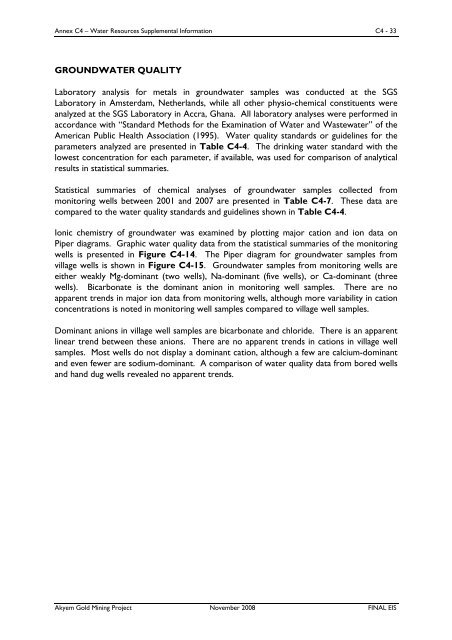annexc - Newmont Mining Corporation
annexc - Newmont Mining Corporation
annexc - Newmont Mining Corporation
You also want an ePaper? Increase the reach of your titles
YUMPU automatically turns print PDFs into web optimized ePapers that Google loves.
Annex C4 – Water Resources Supplemental Information C4 - 33<br />
GROUNDWATER QUALITY<br />
Laboratory analysis for metals in groundwater samples was conducted at the SGS<br />
Laboratory in Amsterdam, Netherlands, while all other physio-chemical constituents were<br />
analyzed at the SGS Laboratory in Accra, Ghana. All laboratory analyses were performed in<br />
accordance with “Standard Methods for the Examination of Water and Wastewater” of the<br />
American Public Health Association (1995). Water quality standards or guidelines for the<br />
parameters analyzed are presented in Table C4-4. The drinking water standard with the<br />
lowest concentration for each parameter, if available, was used for comparison of analytical<br />
results in statistical summaries.<br />
Statistical summaries of chemical analyses of groundwater samples collected from<br />
monitoring wells between 2001 and 2007 are presented in Table C4-7. These data are<br />
compared to the water quality standards and guidelines shown in Table C4-4.<br />
Ionic chemistry of groundwater was examined by plotting major cation and ion data on<br />
Piper diagrams. Graphic water quality data from the statistical summaries of the monitoring<br />
wells is presented in Figure C4-14. The Piper diagram for groundwater samples from<br />
village wells is shown in Figure C4-15. Groundwater samples from monitoring wells are<br />
either weakly Mg-dominant (two wells), Na-dominant (five wells), or Ca-dominant (three<br />
wells). Bicarbonate is the dominant anion in monitoring well samples. There are no<br />
apparent trends in major ion data from monitoring wells, although more variability in cation<br />
concentrations is noted in monitoring well samples compared to village well samples.<br />
Dominant anions in village well samples are bicarbonate and chloride. There is an apparent<br />
linear trend between these anions. There are no apparent trends in cations in village well<br />
samples. Most wells do not display a dominant cation, although a few are calcium-dominant<br />
and even fewer are sodium-dominant. A comparison of water quality data from bored wells<br />
and hand dug wells revealed no apparent trends.<br />
Akyem Gold <strong>Mining</strong> Project November 2008 FINAL EIS











